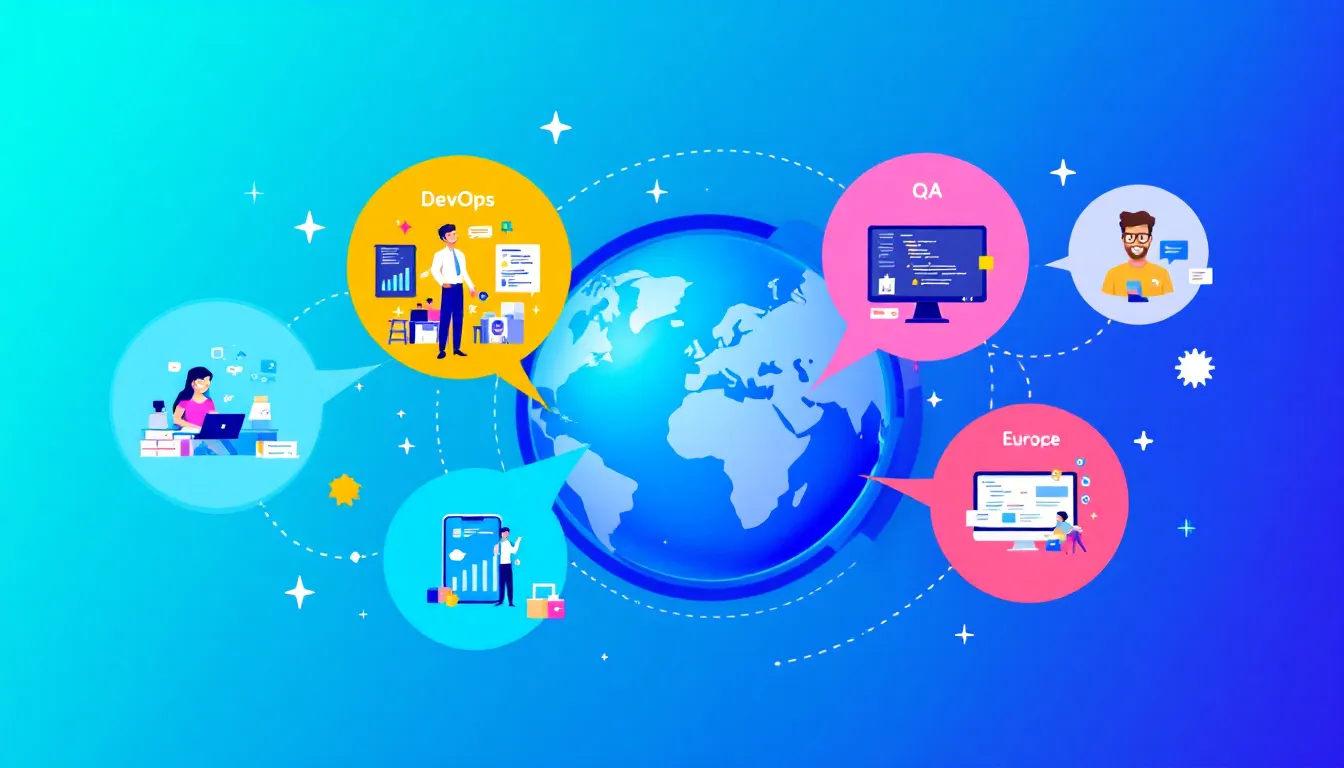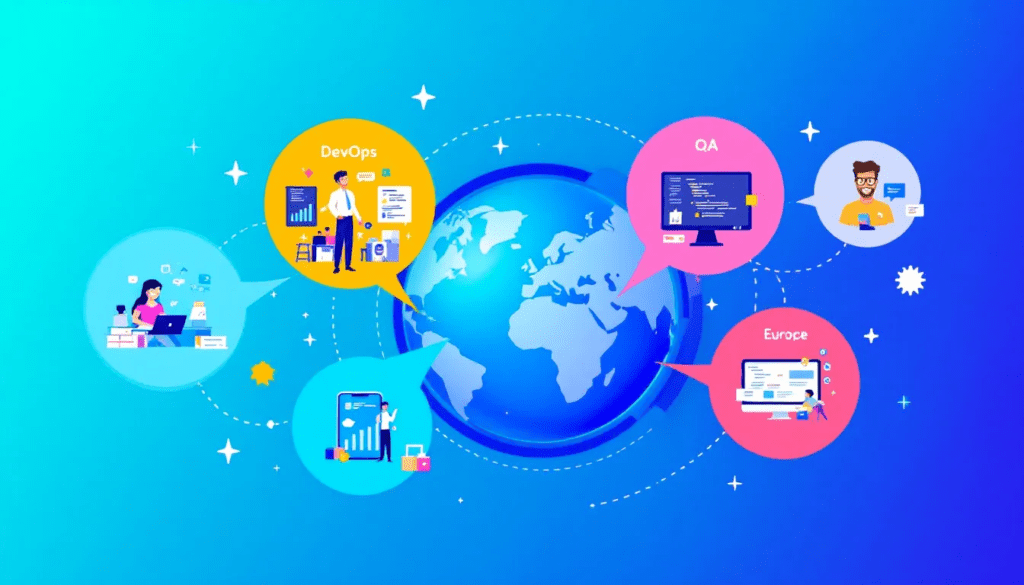Nearshore staff are teams from nearby countries that offer improved communication and collaboration. This guide explains the different models, benefits, and real-world examples to help you decide if nearshoring fits your business needs.
Key Takeaways
- Nearshore staffing enables businesses to hire development teams from nearby countries, facilitating better communication and collaboration compared to offshore models.
- There are three main nearshore staffing models: Dedicated Teams, Team Augmentation, and Project-Based Staffing, each tailored to different business needs.
- The benefits of nearshore staffing include cost efficiency, cultural alignment, and real-time collaboration, which collectively enhance project outcomes.
What is Nearshore Staff?

Nearshore staffing refers to a nearshore outsourcing model that utilizes the nearshore software development model, where businesses hire development teams from nearby countries, typically within the same continent or time zone. This proximity facilitates smoother communication and collaboration compared to offshore development, where teams are located in distant time zones.
Leveraging nearshore software development outsourcing staff allows businesses to access bespoke software solutions tailored to their specific project needs while benefiting from cultural and geographical alignment through nearshore software development services.
Types of Nearshore Staffing Models
There are several models for engaging nearshore staff, each offering unique advantages. The three main models are Dedicated Teams, Team Augmentation, and Project-Based Staffing.
Knowing these models aids in selecting the right approach for your business needs.
Dedicated Teams
A dedicated team model focuses on long-term collaboration, allowing businesses to leverage specialized skills tailored to project requirements. These teams are often contracted at a fixed monthly price and are known for their expertise in areas such as UX design, which includes root cause analysis, interface architecture, animation design, and post-analysis.
Dedicated UX teams that incorporate a design-thinking approach enhance usability and user experience.
Team Augmentation
Team augmentation involves integrating nearshore developers into existing in-house teams to fill skill gaps. These developers are typically proficient in English and can adapt quickly to the preferred collaboration tools of the in-house team.
The internal team provides direction and owns the project outcome, ensuring seamless integration and enhanced capabilities.
Project-Based Staffing
Project-based staffing allows companies to access fully managed teams that handle all stages of project management software development, from planning to ongoing support. This model, also known as managed team nearshoring, involves hiring a team of developers to build updates or features for an existing project, coordinated by in-house project managers.
Benefits of Hiring Nearshore Staff
Hiring nearshore staff offers numerous benefits, including cost efficiency, cultural alignment, and real-time collaboration. These advantages make nearshore staffing an attractive option for businesses looking to enhance project outcomes and maintain high-quality standards.
Cost Efficiency
Nearshore staffing typically offers significant cost savings compared to onshore options while maintaining project quality. ABC Enterprises, for instance, reported a 30% decrease in development costs after shifting to nearshore staffing.
Utilizing nearshore staff can potentially cut development costs in half compared to traditional approaches.
Cultural Alignment
Cultural similarities between nearshore teams and clients enhance team cohesion and project outcomes. Countries like Argentina and Colombia offer skilled professionals with strong cultural affinity with the USA, facilitating smoother collaboration and better teamwork.
Real-Time Collaboration
Real-time collaboration is made possible by the minimal time zone differences encountered with nearshore staffing. This alignment enables real-time responses, improving decision-making and avoiding delays that could hinder project competitiveness.
How to Find the Right Nearshore Staff
Finding the right nearshore staff involves assessing technical skills, evaluating communication skills, and checking past experience. Establishing clear expectations and preparing detailed job descriptions are essential steps in this process.
Assess Technical Skills
Evaluating technical expertise is crucial to ensure that nearshore staff can effectively contribute to software development projects. Look for certifications such as ISO 27001 to ensure adherence to data security standards.
Evaluate Communication Skills
Communication skills are vital for nearshore software developers who interact with various stakeholders during a project. Regular review sessions and bilingual project managers facilitate smoother communication between teams.
Check Past Experience
Examining a candidate’s previous projects offers insight into their problem-solving abilities and technical skills. Analyzing reviews or case studies of a developer’s previous work can give a clearer picture of their contributions and impact.
Integrating Nearshore Staff into Your In-House Team
Effective integration of nearshore staff is crucial for successful collaboration. This involves a structured onboarding process, utilizing collaborative tools, and providing regular feedback and reviews to ensure alignment and continuous improvement.
Onboarding Process
An effective onboarding process is crucial for integrating nearshore staff and ensuring they are productive from the start. Establishing clear job expectations from the outset helps nearshore staff feel more comfortable and productive.
Collaborative Tools
Utilizing platforms that facilitate real-time communication is essential for enhancing productivity between nearshore and in-house teams. Popular collaboration tools like Slack and Microsoft Teams facilitate seamless communication and project coordination across geographically dispersed teams.
Regular Feedback and Reviews
Regular feedback sessions and performance reviews improve team alignment and foster a culture of continuous improvement within software development projects. Structured evaluations based on defined metrics provide constructive feedback to enhance team members’ skills and performance.
Challenges of Nearshore Staffing and How to Overcome Them
Challenges in nearshore staffing include language barriers, time zone management, and security concerns. Effectively addressing these challenges is crucial for successful nearshore collaboration.
Language Barriers
Language barriers can complicate communication and understanding in nearshore staffing. Strategies like cultural sensitivity training foster a more collaborative and productive work environment.
Time Zone Management
Effective management of time zones is crucial for ensuring productivity and seamless collaboration with nearshore teams. Defined times for communication and collaboration between teams maximize productivity.
Security Concerns
Safeguarding data and intellectual property is crucial when working with nearshore staff. Regular training on data security measures and having a Non-Disclosure Agreement (NDA) in place protect intellectual property.
Top Nearshore Software Development Destinations
Latin America is a favored nearshore software development destination due to its close proximity to the U.S. and a growing pool of skilled developers. Mexico, Colombia, and Argentina are popular for their tech talent and economic strength.
Mexico
Mexico is recognized for its substantial IT exports, exceeding $21 billion, making it a key player in the nearshore software development market. Cities like Guadalajara and Mexico City are known for their robust tech development, attracting talent and investment.
Colombia
Outsourcing has become a significant trend in Colombia, positioning the country as an attractive destination for tech companies. Colombia’s GDP is more than $100 billion, showcasing its economic strength and potential as a competitive market.
Argentina
Argentina’s software industry places a strong emphasis on serving export markets, enhancing its role in nearshore development. Cultural similarities between Argentine professionals and U.S. companies foster smoother communication and collaboration.
Case Studies of Successful Nearshore Staffing
Several companies have successfully utilized nearshore staffing to enhance their software development capabilities. Case studies of XYZ Company, ABC Enterprises, and Tech Innovators Inc. provide valuable insights into the benefits and outcomes of nearshore software development companies collaboration.
Case Study 1: XYZ Company
XYZ Company utilized a nearshore software development company team to expedite the development companies of a critical software solution. This collaboration improved efficiency and accelerated time-to-market for their products.
Case Study 2: ABC Enterprises
ABC Enterprises engaged with nearshore staff to enhance their software development capabilities. This strategic move led to substantial cost savings and improved project outcomes.
Case Study 3: Tech Innovators Inc.
Tech Innovators Inc. successfully integrated nearshore staff to enhance their development capacity. Team augmentation expanded their skillset and enabled them to handle larger projects efficiently.
Summary
This guide has explored the complete landscape of nearshore staffing for software development, from understanding its basics to exploring its benefits and overcoming its challenges. Nearshore staffing offers significant advantages in terms of cost efficiency, cultural alignment, and real-time collaboration. By following best practices in finding and integrating nearshore staff, businesses can enhance their software development capabilities and achieve better project outcomes.
Frequently Asked Questions
What is nearshore staffing in software development?
Nearshore staffing in software development involves outsourcing teams from nearby countries within the same continent or time zone, enhancing communication and collaboration efficiency compared to offshore development. This approach is beneficial for organizations seeking reliable partnerships with fewer logistical challenges.
What are the main benefits of hiring nearshore staff?
Hiring nearshore staff offers cost efficiency, cultural alignment, and the advantage of real-time collaboration, all of which contribute to improved project outcomes and the maintenance of high-quality standards.
How do I find the right nearshore staff for my project?
To find the right nearshore staff for your project, assess their technical skills, communication abilities, and past experiences while providing clear expectations through detailed job descriptions. This approach ensures alignment with your project requirements.
What are the common challenges of nearshore staffing, and how can they be overcome?
Language barriers, time zone management, and security concerns are common challenges in nearshore staffing. These issues can be effectively addressed through cultural sensitivity training, aligning overlapping business hours, and conducting regular security audits.
Which countries are top destinations for nearshore software development?
Mexico, Colombia, and Argentina are prime destinations for nearshore software development, offering skilled tech talent and cultural similarities with the USA. These countries present a compelling option for businesses looking to enhance their software development capabilities efficiently.
